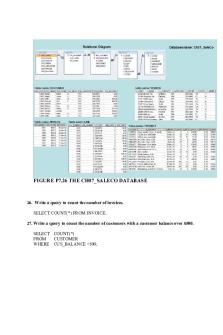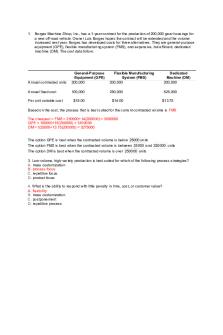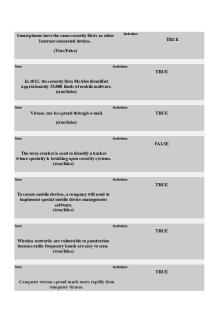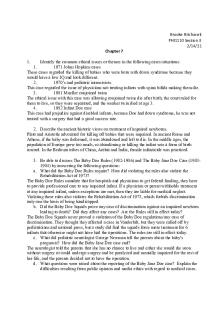Ch7 Simpling Sampling Distributions Unfilled PDF

| Title | Ch7 Simpling Sampling Distributions Unfilled |
|---|---|
| Course | Data Analysis For Managers |
| Institution | Florida Atlantic University |
| Pages | 17 |
| File Size | 1 MB |
| File Type | |
| Total Downloads | 52 |
| Total Views | 138 |
Summary
Chapter 7 filled notes...
Description
Chapter 7: Sampling and Sampling Distributions Study Modules (PPT presentations):
Sampling and Sampling Distributions Interval Estimation
Excel Tutorial:
Selecting a Simple Random Sample
Concepts:
An element is the entity on which _____data________ are collected. A population is a collection of all the ___items_________________ of interest. A sample is a ___subset_______________ of the population. The sampled population is the population from which the ____sample______________ is drawn. A frame is a ___list___________ of the elements that the sample will be selected from. The reason we select a sample is to collect data to answer a research question about a ______________________________. The sample results provide only __estimates_________________ of the values of the population characteristics. The reason is simply that the sample contains only a ___portion________________ of the population. With proper _________sampling_______ methods, the sample results can provide “good” estimates of the population characteristics.
I. Selecting a Sample 1. Sampling from a Finite Population Finite populations are often defined by lists such as: o Organization membership roster o Credit card account numbers o Inventory product numbers
1|Page
A simple random sample of size n from a finite population of size N is a sample selected such that each possible sample of size n has the ____same___________ probability of being ____selected_________________. Replacing each sampled element before selecting subsequent elements is called sampling with _________________________. Sampling without replacement is the procedure used most often. In large sampling projects, computer-generated random numbers are often used to automate the sample selection process. Sampling from a Finite Population Example: St. Andrew’s College St. Andrew’s College received 900 applications for admission in the upcoming year from prospective students. The applicants were numbered, from 1 to 900, as their applications arrived. The Director of Admissions would like to select a simple random sample of 30 applicants.
Reference: Sampling from a Finite Population Using Excel (p. 289)
2. Sampling from an Infinite Population
Sometimes we want to select a sample, but find it is not possible to obtain a list of all elements in the population. As a result, we cannot construct a frame for the population. Hence, we cannot use the random number selection procedure. Most often this situation occurs in infinite population cases. Populations are often generated by an _________________________ where there is no upper limit on the number of units that can be generated. Some examples of on-going processes, with infinite populations, are: o parts being manufactured on a production line 2|Page
o o o
transactions occurring at a bank telephone calls arriving at a technical help desk customers entering a store
In the case of an infinite population, we must select a random sample in order to make valid statistical inferences about the population from which the sample is taken. A random sample from an infinite population is a sample selected such that the following conditions are satisfied. o Each element selected comes from the population of interest. o Each element is selected independently.
II. Point Estimation
Point estimation is a form of ___statistical________________ inference. In point estimation we use the data from the sample to compute a value of a sample _________ that serves as an estimate of a population ____________________. We refer to ´x as the point estimator of the population mean x__. s is the point estimator of the population standard deviation ____. ´p is the point estimator of the population proportion p____.
Point Estimation Example: St. Andrew’s College Recall that St. Andrew’s College received 900 applications from prospective students. The application form contains a variety of information including the individual’s Scholastic Aptitude Test (SAT) score and whether or not the individual desires on-campus housing. At a meeting in a few hours, the Director of Admissions would like to announce the average SAT score and the proportion of applicants that want to live on campus, for the population of 900 applicants. However, the necessary data on the applicants have not yet been entered in the college’s computerized database. So, the Director decides to estimate the values of the population parameters of interest based on sample statistics. The sample of 30 applicants is selected using computer-generated random numbers.
Point Estimation Using Excel:
3|Page
4|Page
Practical Advice: o The _______________ population is the population we want to make inferences about.
o The ________________ population is the population from which the sample is actually taken.
o Whenever a sample is used to make inferences about a population, we should make sure that the targeted population and the sampled population are in close agreement.
III. Sampling Distribution of ´x
5|Page
6|Page
Sampling Distribution of ´x o When the population has a normal distribution, the sampling distribution of x is normally distributed for any sample size. o In most applications, the sampling distribution of x can be approximated by a normal distribution whenever the sample is size _______or more.
o In cases where the population is highly skewed or outliers are present, samples of size __________ may be needed. o The sampling distribution of ´x can be used to provide probability information about how close the sample mean ´x is to the population mean µ.
Central Limit Theorem: o When the population from which we are selecting a random sample does not have a normal distribution, the central limit theorem is helpful in identifying the shape of the sampling distribution of ´x .
o CLT - In selecting random samples of size n from a population, the sampling distribution of the sample mean ´x can be approximated by a normal distribution as the sample size becomes large.
Example: St. Andrew’s College What is the probability that a simple random sample of 30 applicants will provide an estimate of the population mean SAT score that is within +/-10 of the actual population mean µ? In other words, what is the probability that
´x
will be between 1080 and 1100?
Step 1: Calculate the z-value at the upper endpoint of the interval. z = (1100 - 1090)/14.6= .68 7|Page
Step 2: Find the area under the curve to the left of the upper endpoint. P(z < .68) = .7517
Step 3: Calculate the z-value at the lower endpoint of the interval. z = (1080 - 1090)/14.6= - .68 Step 4: Find the area under the curve to the left of the lower endpoint. P(z < -.68) = .2483
8|Page
Step 5: Calculate the area under the curve between the lower and upper endpoints of the interval. P(-.68 < z < .68) = P(z < .68) - P(z < -.68) = .7517 - .2483 = .5034 The probability that the sample mean SAT score will be between 1080 and 1100 is: P(1080 <
´x
< 1100) = .5034
9|Page
Relationship Between the Sample Size and the Sampling Distribution of ´x
Example: St. Andrew’s College o o o
Suppose we select a simple random sample of 100 applicants instead of the 30 originally considered. E( ´x ) =µ regardless of the sample size. In our example, E( ´x ) remains at 1090. is Whenever the sample size is increased, the standard error of the mean σ ´x decreased. With the increase in the sample size to n = 100, the standard error of the mean is decreased from 14.6 to:
σ ´x
o o o o
σ
= √ n = 80/100= 8.0
Recall that when n = 30, P(1080 < ´x < 1100) = .5034. < 1100) when n = 100 as we showed We follow the same steps to solve for P(1080 < ´x earlier when n = 30. < 1100) = .7888. Now, with n = 100, P(1080 < ´x Because the sampling distribution with n = 100 has a smaller standard error, the values of have less variability and tend to be closer to the population mean than the values of ´x with n = 30.
10 | P a g e
IV. Sampling Distribution of ´p
11 | P a g e
12 | P a g e
Example: St. Andrew’s College o Recall that 72% of the prospective students applying to St. Andrew’s College desire oncampus housing. o What is the probability that a simple random sample of 30 applicants will provide an estimate of the population proportion of applicant desiring on-campus housing that is within plus or minus .05 of the actual population proportion? o For our example, with n = 30 and p = .72, the normal distribution is an acceptable approximation because: np = 30(.72) = 21.6 ≥ 5 and n(1-p) = 30(.28) = 8.4 ≥ 5
o Step 1: Calculate the z-value at the upper endpoint of the interval. z = (.77 - .72)/.082 = .61
o Step 2: Find the area under the curve to the left of the upper endpoint. P(z < .61) = .7291
13 | P a g e
o Step 3: Calculate the z-value at the lower endpoint of the interval. z = (.67 - .72)/.082 = - .61
o Step 4: Find the area under the curve to the left of the lower endpoint. P(z < -.61) = .2709
14 | P a g e
o Step 5: Calculate the area under the curve between the lower and upper endpoints of the interval. P(-.61 < z < .61) = P(z < .61) - P(z < -.61) = .7291 - .2709= .4582 o The probability that the sample proportion of applicants wanting on-campus housing will be within +/-.05 of the actual population proportion : P(.67 ≤ ´p ≤
.77) = .4582
15 | P a g e
V. Other Sampling Methods
1. Stratified Random Sampling
o The population is first divided into groups of elements called strata. o Each element in the population belongs to one and only one stratum. o Best results are obtained when the elements within each stratum are as much alike as possible (i.e. a homogeneous group).
o A simple random sample is taken from each stratum. o Formulas are available for combining the stratum sample results into one population parameter estimate. o Advantage: If strata are homogeneous, this method is as “precise” as simple random sampling but with a smaller total sample size.
o Example: The basis for forming the strata might be department, location, age, industry type, and so on. 2. Cluster Sampling
o The population is first divided into separate groups of elements called clusters. o Ideally, each cluster is a representative small-scale version of the population (i.e. heterogeneous group). o A simple random sample of the clusters is then taken.
o All elements within each sampled (chosen) cluster form the sample. o Example: A primary application is area sampling, where clusters are city blocks or other well-defined areas. o Advantage: The close proximity of elements can be cost effective (i.e. many sample observations can be obtained in a short time).
o Disadvantage: This method generally requires a larger total sample size than simple or stratified random sampling. 3. Systematic Sampling
o If a sample size of n is desired from a population containing N elements, we might sample one element for every n/N elements in the population.
o We randomly select one of the first n/N elements from the population list. o We then select every n/Nth element that follows in the population list. o This method has the properties of a simple random sample, especially if the list of the population elements is a random ordering. 16 | P a g e
o Advantage: The sample usually will be easier to identify than it would be if simple random sampling were used.
o Example: Selecting every 100th listing in a telephone book after the first randomly selected listing 4. Convenience Sampling
o It is a nonprobability sampling technique. Items are included in the sample without known probabilities of being selected.
o The sample is identified primarily by convenience. o Example: A professor conducting research might use student volunteers to constitute a sample. o Advantage: Sample selection and data collection are relatively easy. o Disadvantage: It is impossible to determine how representative of the population the sample is. 5. Judgment Sampling
o The person most knowledgeable on the subject of the study selects elements of the population that he or she feels are most representative of the population.
o It is a nonprobability sampling technique. o Example: A reporter might sample three or four senators, judging them as reflecting the general opinion of the senate. o Advantage: It is a relatively easy way of selecting a sample.
o Disadvantage: The quality of the sample results depends on the judgment of the person selecting the sample.
Recommendation
o It is recommended that probability sampling methods (simple random, stratified, cluster, or systematic) be used.
o For these methods, formulas are available for evaluating the “goodness” of the sample results in terms of the closeness of the results to the population parameters being estimated. o An evaluation of the goodness cannot be made with non-probability (convenience or judgment) sampling methods.
17 | P a g e...
Similar Free PDFs

Ch7 - Ch7
- 11 Pages

Ch7
- 4 Pages

Numerical Distributions
- 2 Pages

Franking distributions
- 3 Pages

Probability Distributions
- 3 Pages

Testbank ch7
- 4 Pages

PHI1110 CH7
- 3 Pages
Popular Institutions
- Tinajero National High School - Annex
- Politeknik Caltex Riau
- Yokohama City University
- SGT University
- University of Al-Qadisiyah
- Divine Word College of Vigan
- Techniek College Rotterdam
- Universidade de Santiago
- Universiti Teknologi MARA Cawangan Johor Kampus Pasir Gudang
- Poltekkes Kemenkes Yogyakarta
- Baguio City National High School
- Colegio san marcos
- preparatoria uno
- Centro de Bachillerato Tecnológico Industrial y de Servicios No. 107
- Dalian Maritime University
- Quang Trung Secondary School
- Colegio Tecnológico en Informática
- Corporación Regional de Educación Superior
- Grupo CEDVA
- Dar Al Uloom University
- Centro de Estudios Preuniversitarios de la Universidad Nacional de Ingeniería
- 上智大学
- Aakash International School, Nuna Majara
- San Felipe Neri Catholic School
- Kang Chiao International School - New Taipei City
- Misamis Occidental National High School
- Institución Educativa Escuela Normal Juan Ladrilleros
- Kolehiyo ng Pantukan
- Batanes State College
- Instituto Continental
- Sekolah Menengah Kejuruan Kesehatan Kaltara (Tarakan)
- Colegio de La Inmaculada Concepcion - Cebu








